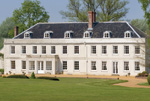Farming and sporting estates for sale in Breckland
Some of the finest farming and sporting estates are to be found on the Norfolk/Suffolk border in Breckland


From Neolithic until Georgian times, Breckland was a vast tract of dry sandy heathland covering 370 square miles either side of the border between Suffolk and Norfolk its name derived from the brecks, or temporary fields cultivated by early farmers and allowed to relapse into wilderness once the soil was exhausted. In days gone by, when asked which county their farm was in, Breckland farmers would say ‘that depends on which way the wind is blowing’, and blow it did, for much of the year.
Sheep and rabbits shared the empty landscape until 18th- and 19th-century landowners began planting trees to halt the constant soil erosion, and Victorian engineers set up irrigation systems to tap into the vast reserves of water trapped in the chalk underground. Gradually, the sandy desert turned green, and it wasn’t long before the sporting local gentry transformed the fields and forests around Thetford into some of the finest mixed farming and sporting estates in England.
Launched on the market in today’s Country Life, at a guide price of ‘excess £10 million’ through Strutt & Parker (020–7629 7282), is the historic Rushford estate, which sits literally on the border between Norfolk and Suffolk, three miles east of Thetford. Owned in the 14th century by Edmund Gonville, founder of Gonville and Caius College in Cambridge, Rushford was leased and later sold by the Crown, in 1599, to Robert Buxton, an astute surveyor and solicitor who managed the Duke of Norfolk’s lands in Norfolk and Suffolk.
For the next 299 years, Rushford was part of the Buxton family’s Shadwell estate, which became their main seat when John Buxton, an amateur architect of some talent, built himself a new house there in 1727–29. Rushford and Shadwell remained in the hands of the Buxtons until 1898, when the heiress Maud Isabel Buxton sold the estates to John Musker, a passionate racehorse-breeder who created the famous Shadwell stud farm.
The stables at Rushford would later house a fine team of polo ponies. The Muskers did much to improve the grounds and buildings both at Shadwell and Rushford, before the latter was eventually sold, in 1977, to the Chambers family, the current vendors.
Hidden among banks of magnificent trees and protected by the grand neighbouring estates of Shadwell, Euston and Elveden, the wonderfully unspoilt, 1,231-acre Rushford estate is one of Breckland’s best-kept secrets, undisturbed by public footpaths or bridleways. The centrepiece of the estate is Grade II-listed Rushford Hall, a charming, light and airy, late-18th-century house built in the style of a French shooting lodge, white-rendered with a Norfolk-pantile roof, which was cleverly extended by the Musker family in the early 1900s. All the main rooms face south over formal lawns bounded by topiaried hedges and woodland; rooms on the other side look out across paddocks to the banks of the Little Ouse, a two-mile stretch of which forms the estate’s northern boundary, and the county border.
The internal layout is simplicity itself, with three main reception rooms to the front a wide panelled entrance hall, a classic Georgian dining room and a delightful drawing room with limed oak panelling, an exquisite French carved fireplace and large sash windows. To the rear, the kitchen and sitting room look out across well-tended paddocks. The five main bedrooms and four bathrooms are all on the first floor, and there is the option to create further bedrooms in the former staff quarters above. To the east of the main house is a heated outdoor pool and the former walled kitchen garden; there is also planning consent to replace the conservatory with an orangery.
Exquisite houses, the beauty of Nature, and how to get the most from your life, straight to your inbox.
The main estate outbuildings and coach house to the west of the hall are beautifully built of traditional brick and flint, as are most of Rushford’s 10 or more houses and cottages. The estate has two stable yards and a variety of modern farm buildings. Thanks to an efficient borehole and irrigation system, the entire property runs off its own private water supply.
Rushford’s 1,200-odd acres is split mainly between some 800 acres of light, sandy arable farmland, used mainly for the production of high-yielding root-crops such as asparagus, onions and sugar beet, and 240-odd acres of woodland that provide the basis for a successful partridge and pheasant shoot. The rest is a mix of heathland and pine forest, which complete the picture of a private haven in this wonderfully timeless corner of England.
Country Life is unlike any other magazine: the only glossy weekly on the newsstand and the only magazine that has been guest-edited by His Majesty The King not once, but twice. It is a celebration of modern rural life and all its diverse joys and pleasures — that was first published in Queen Victoria's Diamond Jubilee year. Our eclectic mixture of witty and informative content — from the most up-to-date property news and commentary and a coveted glimpse inside some of the UK's best houses and gardens, to gardening, the arts and interior design, written by experts in their field — still cannot be found in print or online, anywhere else.
